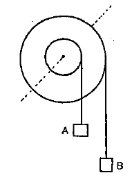In the following figure, a weight W is attached to a string wrapped round a solid cylinder of mass M mounted on a frictionless horizontal axle at O.
If the weight starts from rest and falls a distance h, then its speed at that instant is


1. Proportional to \(\text R\)
2. Proportional to \(1 \over R\)
3. Proportional to \(1 \over R^2\)
4. Independent of \(\text R\)


A solid cylinder rolls down an inclined plane that has friction sufficient to prevent sliding. The ratio of rotational energy to total kinetic energy is
1.
2.
3.
4.
A swimmer while jumping into water from a height easily forms a loop in the air, if
1. He pulls his arms and legs in
2. He spreads his arms and legs
3. He keeps himself straight
4. None of the above
Assertion : A ladder is more apt to slip when you are high up on it than when you just begin to climb
Reason : At the high point on a ladder, the torque is large and on climbing up the torque is small
- If both the assertion and the reason are true and the reason is a correct explanation of the assertion
- If both the assertion and reason are true but the reason is not a correct explanation of the assertion
- If the assertion is true but the reason is false
- If both the assertion and reason are false
An inclined plane makes an angle of with the horizontal. A solid sphere rolling down this inclined plane from rest without slipping has a linear acceleration equal to
1.
2.
3.
4.
The figure shows a small wheel fixed coaxially on a bigger one of double the radius. The system rotates about the common axis. The strings supporting A and B do not slip on the wheels. If x and y be the distances traveled by A and B in the same time interval, then

1. x-2y
2. x = y
3. y=2x
4. none of these
If a gymnast, sitting on a rotating stool, with his arms outstretched, suddenly lowers his hands
1. the angular velocity increases
2. his moment of inertia increases
3. the angular velocity stays constant
4. the angular momentum increases
Moment of inertia of a uniform circular disc about a diameter is I. Its moment of inertia about an axis perpendicular to its plane and passing through a point on its rim will be
1. 5 I
2. 3 I
3. 6 I
4. 4 I
A disc and a solid sphere of the same radius but different masses roll off on two inclined planes of the same altitude and length. Which one of the two objects gets to the bottom of the plane first?
1. Disk
2. Sphere
3. Both reach at the same time
4. Depends on their masses
The rotational KE of a body is E and its moment of inertia is I. The angular momentum is
1. EI
2.
3.
4.



